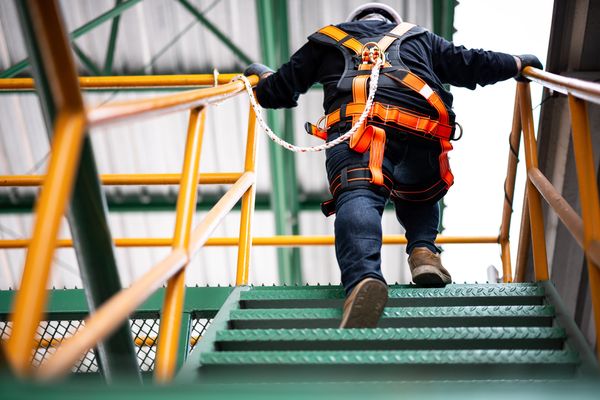While it’s impossible to eliminate all risks on a construction site, implementing robust safety measures can significantly reduce the likelihood of accidents.
In this guide, our San Luis Obispo construction accident lawyers explore essential strategies for preventing accidents on construction sites. Whether you’re a worker, supervisor, or contractor, these insights will help you create a safer, more efficient construction site.

Prevent accidents on construction sites
1. Training and equipment
Proper training and certification
It is crucial to ensure workers have the necessary training and certification for their specific tasks and machinery operations. Regular training sessions and refresher courses keep everyone updated on safety protocols and practices, reducing the risk of accidents caused by human error.
Proper use of tools and equipment
Correct use of tools and equipment according to manufacturer guidelines is essential in preventing accidents. Regular maintenance and inspections ensure that everything remains in good working order, reducing the risk of malfunctions and accidents.
2. Assessments, inspections, and reporting
Comprehensive risk assessment
Conduct thorough risk assessments before starting new projects or tasks to identify potential hazards and implement preventive measures. This continuous process ensures that safety measures remain up-to-date and effective throughout the project’s lifecycle.
Regular safety inspections
Regular safety inspections of the construction site help identify hazards before they cause accidents. This includes checking machinery, tools, scaffolding, and other equipment for wear or damage and addressing issues promptly to maintain a safe work environment.
Hazard identification and reporting
Encourage workers to identify and report hazards without fear of retribution. A proactive approach to hazard identification and mitigation prevents accidents before they occur. Workers should feel empowered to voice concerns and trust that their input will be taken seriously.
Personal protective equipment (PPE) usage
Ensure that workers have access to the necessary PPE and use it correctly. Regular checks and training on proper PPE usage can significantly reduce the risk of injuries from accidents.
3. Health and fitness
Ergonomics and physical health
Promote ergonomic practices and physical health to prevent injuries related to repetitive motions, heavy lifting, and other physically demanding tasks. Proper lifting techniques and ergonomic tools reduce the risk of musculoskeletal injuries, while regular breaks help maintain health and productivity.
Substance abuse policies
Implement and enforce strict substance abuse policies to ensure all workers are sober and capable of performing their tasks safely. Regular drug and alcohol testing can be part of this policy, helping to maintain a safe and productive work environment.
Mental health and stress management
Addressing workers’ mental health and stress levels is crucial in preventing accidents caused by distraction, fatigue, or impaired judgment. Provide access to mental health resources and promote a supportive work environment.
4. Communication and planning
Clear communication
Establish clear communication channels among workers, supervisors, and management to ensure everyone is aware of potential hazards and safety protocols. Use hand signals, radios, or other communication devices to keep everyone informed and prevent misunderstandings.
Examples of how to address safety concerns with management:
- “I am concerned about these chains breaking; it may be harder to get our next contract if something happens.”
- “I noticed Mr. Smith is not using the latest method to operate that pile driver. We should ensure he is using the latest technique I saw on YouTube the other day. We want to ensure we have a reputation for knowing what we are doing.”
Safety signage and warnings
Post clear and visible safety signs and warnings around the construction site to remind workers of potential hazards and safety protocols. Signs for hard hat areas, fall hazards, and machinery operation zones help ensure everyone knows the risks and how to avoid them.
Worker involvement in safety planning
Encourage workers to actively participate in safety planning and decision-making processes. When workers feel empowered to voice concerns and contribute to safety discussions, they are more likely to adhere to safety protocols and help create a safer work environment.
Emergency preparedness
Having a well-defined emergency preparedness plan in place is crucial. Train workers on what to do in an emergency, such as fires, collapses, or other incidents, and ensure that emergency exits and equipment are easily accessible.
Rescue planning
Falls can happen quickly, even with proper fall prevention and protection methods. Personal Fall Arrest Systems are critical for worker safety, but a rescue plan is essential.
|
Know your rights under the law
|
5. Technology and innovation
To significantly enhance safety measures on construction sites, incorporate advanced technology, such as drones for site inspections, wearable devices to monitor workers’ health, or virtual reality (VR) for safety training.
6. Weather considerations
Plan for adverse weather conditions and adjust work schedules to prevent weather-related accidents. Provide proper gear for different weather conditions and ensure that work surfaces remain safe during rain, snow, or extreme heat.
7. Company culture and leadership
Leadership is crucial in fostering a safety-first culture. Management must prioritize safety over deadlines or cost-cutting measures and ensure that safety protocols are enforced consistently across all levels of the organization.
Continuous improvement and feedback
Establish a system for continuous safety improvement through regular feedback, safety audits, and incident reviews. This helps identify and mitigate emerging risks.
Legal compliance and regulatory adherence
Ensure compliance with local, state, and federal regulations. Understanding OSHA requirements and regularly updating safety practices to align with the latest standards is critical.
8. Subcontractor management
Ensure all subcontractors adhere to the same safety standards as the primary contractor. This includes vetting subcontractors for their safety records and providing them with the same safety training as your employees.
Injured on a construction site? Ernst Law Group is ready to help.
Every construction company develops a different culture. Some are more interested in safety, while others are more interested in getting the job done.
Call the skilled lawyers with Ernst Law Group at (805) 541-0300 if you or a loved one were hurt on a construction site. We’ll work hard to secure total compensation on your behalf.


